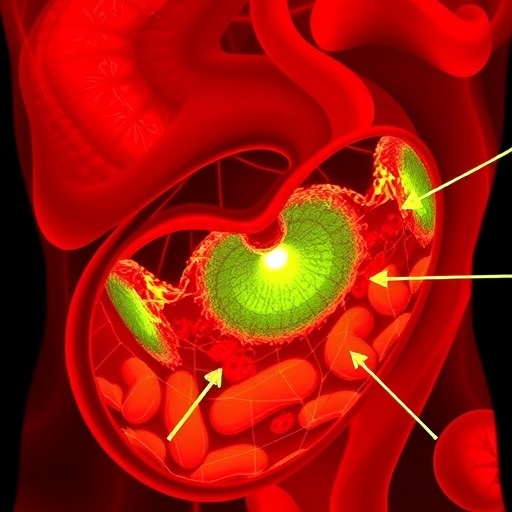In a pioneering leap for pediatric medicine, researchers have unveiled a novel, minimally invasive diagnostic approach for biliary atresia (BA), powered by artificial intelligence (AI). This breakthrough method is set to revolutionize the way clinicians identify this rare yet life-threatening liver condition, which primarily affects newborns and infants. The study presents an AI-driven diagnostic model that surpasses current invasive procedures in accuracy and patient comfort, promising a new era of early diagnosis and improved outcomes.
Biliary atresia is a severe neonatal hepatic disorder characterized by obstruction or absence of bile ducts, leading to progressive liver damage and eventual liver failure if untreated. The current diagnostic gold standard involves invasive surgical exploration or cholangiography, which carries risks and delays crucial intervention. Early detection is paramount, as timely surgical treatment dramatically enhances survival rates and can obviate the need for liver transplantation. Against this backdrop, the introduction of an AI-empowered, minimally invasive diagnostic system could shift paradigms in clinical management.
The research team, comprising experts in hepatology, pediatric surgery, and data science, meticulously developed a diagnostic algorithm calibrated on a diverse cohort of infants suspected of having biliary atresia. Employing advanced machine learning techniques, the model integrates multidimensional clinical data, laboratory parameters, and imaging characteristics to discern BA from other causes of neonatal cholestasis. This integrative approach leverages the nuanced patterns and subtle biomarkers often imperceptible to human observers but computable by AI.
Technically, the model is rooted in deep learning architectures, likely convolutional neural networks, optimized for pattern recognition across ultrasound images and serological data. The diagnostic pipeline was rigorously trained and validated against a robust dataset, ensuring high sensitivity and specificity. Emphasizing reproducibility and generalizability, the dataset included multi-center inputs, reflecting diverse patient demographics and clinical presentations essential for real-world applicability.
The model’s performance metrics are particularly impressive. It achieved diagnostic accuracy surpassing that of conventional clinical algorithms and competitor AI models tested on similar datasets. Sensitivity and specificity metrics indicate that the algorithm minimizes false negatives—a critical aspect to ensure no cases pending urgent treatment are overlooked—and also reduces false positives, preventing unnecessary invasive procedures. These balanced trade-offs underscore the AI system’s clinical reliability.
From a minimization of invasiveness standpoint, the model relies primarily on non-invasive imaging and accessible laboratory tests rather than surgical or endoscopic techniques. This dramatically reduces patient discomfort, procedural risks, and healthcare costs. Moreover, the AI-based method shortens the diagnostic timeline, permitting faster clinical decisions and potential initiation of treatment within the narrow therapeutic window that defines biliary atresia management success.
The interdisciplinary collaboration highlighted in this work showcases the fusion of cutting-edge computational science with pediatric hepatology, underscoring how AI is no longer a futuristic concept but an immediate translational tool within clinical workflows. By harnessing AI’s ability to process vast, complex datasets rapidly and accurately, clinicians are empowered to diagnose challenging cases with unprecedented precision and timeliness.
One of the study’s critical contributions is its emphasis on explainability and clinician integration. The AI model is designed with transparency features that provide interpretable outputs, ensuring that healthcare providers can understand and trust the diagnostic suggestions. This addresses a common barrier in AI adoption—the ‘black box’ problem—thereby facilitating acceptance and smoother implementation in medical settings.
While the research demonstrates groundbreaking potential, the authors prudently acknowledge the necessity for further extensive clinical trials and cross-population validations. Such future studies are crucial to fine-tune the model’s predictive capabilities, address any biases inherent in initial training data, and verify efficacy across varied healthcare infrastructures globally. The promising preliminary results, however, signal a paradigm shift in pediatric diagnostics.
Additionally, this AI application aligns with broader movements in precision medicine, where individualized diagnostic and therapeutic strategies are increasingly emphasized. The model’s capacity to analyze granular patient-specific data and guide personalized clinical decisions exemplifies this trend. It illustrates how digital innovations can systematically transform not only diagnosis but also overall patient management strategies.
The societal impact of this development may also extend beyond immediate clinical practice. By potentially reducing the need for liver transplants and long hospitalizations, healthcare systems could see significant economic benefits. Families endure less anxiety and trauma associated with invasive procedures and delayed diagnoses, improving overall psychological and quality-of-life outcomes for affected infants and their caregivers.
A critical dimension is the ethical framework surrounding AI deployment in pediatric care. The researchers have underscored rigorous data privacy standards and ensured algorithmic fairness in design to mitigate disparities in healthcare access or outcomes. This proactive approach is vital for maintaining public trust and ethical integrity as AI tools become increasingly embedded in sensitive and high-stakes medical environments.
This study not only opens new frontiers for biliary atresia but also exemplifies how AI can be strategically leveraged in rare disease diagnostics where clinical uncertainty and procedural risks are high. Its success could inspire similar innovations across other pediatric conditions characterized by diagnostic challenges, setting a new benchmark in child health technology integration.
In summary, the development and validation of this minimally invasive AI diagnostic model herald a new chapter for biliary atresia management. Marrying accuracy with safety and efficiency, it offers hope for dramatically improving patient outcomes. As AI technology continues to evolve and embed itself deeper within clinical settings, such transformative approaches underscore the immense potential residing at the intersection of artificial intelligence and pediatric healthcare.
Subject of Research: Development and validation of a minimally invasive diagnostic model for biliary atresia using artificial intelligence
Article Title: Development and validation of a minimally invasive diagnostic model for biliary atresia using artificial intelligence
Article References:
Jiang, JY., Dong, R., Sun, YH. et al. Development and validation of a minimally invasive diagnostic model for biliary atresia using artificial intelligence. World J Pediatr (2025). https://doi.org/10.1007/s12519-025-00988-2
Image Credits: AI Generated
DOI: 10.1007/s12519-025-00988-2




